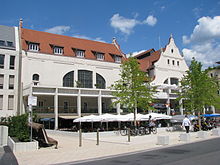Franz Sales Kuhn
Franz Sales Kuhn (born February 2, 1864 in Ehaben , † October 18, 1938 in Munich ) was a German architect who designed numerous buildings, especially in Heidelberg .
Life
Franz Sales Kuhn spent his childhood and school days in Ehaben, south of Freiburg im Breisgau . After his military service as a one-year volunteer in Metz (in Alsace-Lorraine, then part of the German Empire ), he began an apprenticeship as a carpenter. After an accident at work in which he lost four fingers of his left hand, he had to break off the apprenticeship. He then went to Munich and studied at the Royal School of Applied Arts in Munich with Leonhard Romeis . He then worked for four years in the studio of the glass painter and artisan Alexander Linnemann in Frankfurt am Main . From 1896 he worked at the Archbishop's Building Office in Heidelberg. In 1898 he settled in Heidelberg as a freelance architect, where he designed numerous private and public buildings and decisively shaped the cityscape between the turn of the century and the 1930s. Later, Kuhn also increasingly took on orders outside Heidelberg, mainly in Baden .
In 1911 he married Madeleine Caritas Regnier (1887–1955). In 1924 the city of Heidelberg granted him honorary citizenship because of his services "to the design of the Heidelberg cityscape" . He died in 1938 while on a business trip in Munich and is buried in the Heidelberg Bergfriedhof . Kuhn was a member of the Association of German Architects and the German Werkbund .
architecture
As an employee of the Archbishop's Building Office, he created designs for the Heilig-Geist-Kirche in Mannheim and the Church of St. Bonifatius in Heidelberg, which were not realized, but were carried out in a modified form by Ludwig Maier .
Kuhn's works include numerous villas, mainly in the Heidelberg districts of Neuenheim and Handschuhsheim , apartment buildings, gardens, tombs and a number of public buildings. From 1929 he turned to church building again.
Kuhn took part in architectural competitions more often , for example for the Dresden City Hall , the Mainz District Court , the Peace Palace in The Hague or the new lecture hall building at Heidelberg University . His plans were mostly positively appraised and often awarded prizes, but were never implemented.
Kuhn's architecture, which often followed the client's wishes, was initially kept in a toned-down historicism , which he, however , was soon critical of , especially the “German Renaissance” . He turned to reform architecture and neoclassicism and tried to combine traditional building forms with the demand for functional spaces. Art Nouveau elements can be found again and again , even if Kuhn did not design any pure Art Nouveau buildings. After the First World War, he oriented himself towards the homeland security movement ; only in a short phase from 1927 to 1929 did Kuhn pick up on modern tendencies that were based partly on the New Objectivity and partly on neoclassical monumentalism.
plant
- before 1900: Design for the Church of St. Bonifatius in Heidelberg
- 1903–1906: Veth's indoor swimming pool in Heidelberg
- 1907: Expansion of the Leonensia connection house in Heidelberg
- 1910–1911: Women's club home, called “Marie-Luisen-Heim”, in Heidelberg
- 1911–1924: New Baroque extension of the Heidelberg town hall
- 1922–1923: Bank building for the Süddeutsche Discount Society in Heidelberg (used today by Deutsche Bank)
- 1925: Reconstruction and modernization of the castle hotel in Heidelberg
- 1924–1928: Radium brine bath in Heidelberg, Vangerowplatz
- 1926–1928: Church of Reconciliation in Völklingen
- 1929–1930: Sacred Heart Church in Bad Rappenau
- 1929–1930: Church of St. Wendelin in Heidersbach (today the municipality of Limbach )
- 1930: St. Raphael School in Heidelberg
- 1930–1931: Holy Cross Church in Grötzingen
- 1930–1931: Maria Regina Pacis Chapel in Bad Griesbach in the Black Forest
- 1933–1934: Expansion of the St. Vitus Church in Heidelberg-Handschuhsheim
- 1933–1935: St. Albert Church in Heidelberg
- 1936: Stadtgartencasino in Heidelberg
- 1936: Memorial of the Baden fire brigade in Achern
literature
- Kai Budde: The architect Franz Sales Kuhn (1864–1938). (= Publications on Heidelberg Old Town , Volume 18.) Heidelberg 1983.
- Hans Gercke: Churches in Heidelberg. Schnell and Steiner, Regensburg 2011, ISBN 978-3-7954-2413-8 , S. #.
Web links
Individual evidence
- ^ Photo of the tombstone , Heidelberg History Association
- ^ Gabriele Dörflinger: Student connections in Heidelberg. A city tour . Heidelberg University Library, Heidelberg 2017, p. 30 .
| personal data | |
|---|---|
| SURNAME | Kuhn, Franz Sales |
| BRIEF DESCRIPTION | German architect |
| DATE OF BIRTH | February 2, 1864 |
| PLACE OF BIRTH | Bring |
| DATE OF DEATH | October 18, 1938 |
| Place of death | Munich |



